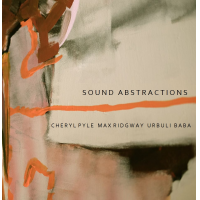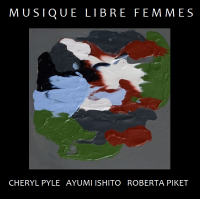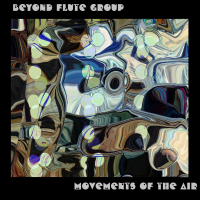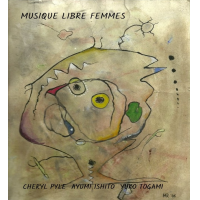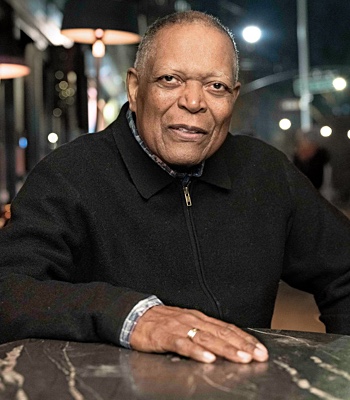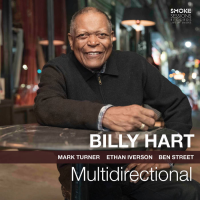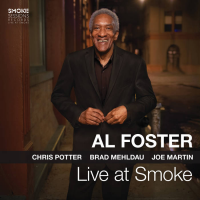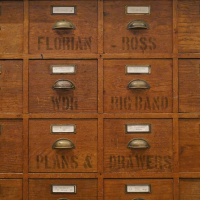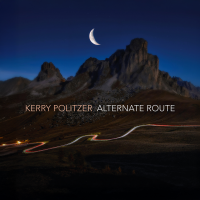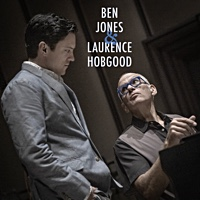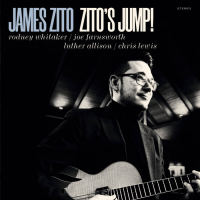*****REVIEWS*****
LOFT JAZZ ON PIER 50 Bay Guardian, San Francisco, Sept 20,
1979
The idea behind Loft Jazz according to it articles of
incorporation is to "provide an environment ... to bring
musicians together in playing and listening situations where
ideas can be exchanged, to develop and promote an
appreciation of jazz music in a non-commercial atmosphere
conducive to attentive listening." At the Monday night jam
session at Bethany Methodist Church, SF, musicians have been
a fixture for quite a while and have attracted such local
talent as Dave Ginsberg, Mike Koskinen, Bishop Norman
Williams, and Cheryl Pyle. review by Kerrigan Black
SAIL AWAY -TOM HARRELL - AMG Review
Recorded in 1989 and re-released on Original Jazz Classics
in 2003, Sail Away is a fine outing by trumpeter Tom
Harrell. He's joined by pianist James Williams, bassist Ray
Drummond, and drummer Adam Nussbaum. A handful of guests —
flutist Cheryl Pyle, guitarist John Abercrombie, tenor Joe
Lovano, and soprano Dave Liebman — fill out the arrangements
on ten instrumentals (two are bonus cuts from Visions).
Together, Harrell and company add a contemporary spin to
mainstream jazz. The ten-minute track "Dream in June" takes
a number of adventurous flights of fancy without ever losing
track of its base. Both Harrell and Abercrombie's solos
build complex, forceful ideas against a backdrop of
Nussbaum's powerful drumming, creating a dense sound that
belies predictability. Harrell and Lovano's horns entwine on
"Glass Mystery"'s intro, concocting a late-night mood for
this lovely piece, while Pyle's flute adds the right touch
to the meditative "Dancing Trees." Each track of Sail Away
unfolds like an impressionistic canvas, bursting with color
and light, with every brush stroke working toward the sum
total of the painting. Modern jazz fans looking for music
that's grounded — but never imprisoned — by yesteryear will
want to pick up a copy. ~ Ronnie D. Lankford Jr., All Music
Guide
http://music.msn.com/music/album/tom-harrell/sail-
away.1/Sail Away [Original Jazz Classics]: Critic's Review
TRIUMPH OF "FORM" OVER DAUNTING ODDS Los Angeles Times TOM
HARRELL "FORM" contemporary records 1990
Constantly evolving as a composer and soloist, the former
Phil Woods sideman illustrates how much can be achieved with
two-part harmony: his own trumpet or fluegelhorn and Joe
Lovano on sax. A ringer, Cheryl Pyle on flute is added for
"January Spring" a complex and challenging piece in which
everyone, including Panamanian pianist Danilo Perez, 23,
plays a valuable role. Neil Tesser's notes deal sensitively
with Harrell's emotional problem (a diagnosed schizophrenic,
he seems to come alive only when he puts the horn to his
lips). rather than pity him, as Tesser points out, we should
admire him and marvel at the creativity that has defied such
daunting odds.
Leonard Feather
"FORM -tom harrell-illustrates how much can be achieved with
two-part harmony,with joe lovano on soprano, cheryl pyle on
flute,added for january spring- a complex and challenging
piece in which everyone, including bassist charlie haden and
pianist danilo perez plays a valuable role."
- leonard feather, la times -jazz reviews
Tom Harrell -Passages- CD
This CD is most notable for featuring ten of trumpeter Tom
Harrell's compositions. Few of the melodies from the
harmonically advanced originals will stick in one's mind
after one or two listens, but the solos are excellent (and
in Harrell's case, often exquisite) and the generally
melancholy moods of the advanced hard bop pieces are
memorable in their own way. In addition to Harrell, Joe
Lovano is in fine form on tenor, soprano and alto, Cheryl
Pyle's two guest appearances on flute are a bonus and the
rhythm section is supportive and alert with pianist Danilo
Perez emerging as a major soloist, taking the title cut as a
lyrical free improvisation duet with Harrell. An intriguing
and thought-provoking session. ~ Scott Yanow
Recorded at BMG Studio A, New York, New York on October 10 &
11, 1991.
Includes liner notes by Ken Franckling.
Personnel: Tom Harrell (trumpet, flugelhorn); Cheryl Pyle
(flute); Joe Lovano (soprano saxophone, alto saxophone,
tenor saxophone); Danilo Perez (piano); Ben McGlinn (ARP
synthesizer); Paul Motian (drums); Café (percussion).
KITTY BRAZELTON'S REAL MUSIC SERIES MUSIC PARTY IV 12/19/93
-BURN: SONGS TO BRING BACK THE SUN
a Sunday Saturnalia in celebration of the winter solstice
Sunday at CB's gallery-extension of CBGB's
With DADADA, Cheryl Pyle, Tom Varner, Cellovision!, David
Krakauer, Roland Wilson, Christine Bard & Jim Pugliese, and
others.
KNITTING FACTORY KNOTES MAY JUNE 1997, ALTERKNIT THEATER —
CHERYL PYLE QUARTET
THE CHERYL PYLE QUARTET has an abstract straight-ahead, if
not ethereal quality which inspires intricate textural and
rhythmic variety in the improvisations. Featuring David
Phelps guitar, Stephan Crump bass, Kirk Driscoll drums and
Cheryl Pyle flute.
JAZZ ARISTS PERFORM A NJCVA NJ SUMMIT OBSERVER, Thursday
Sept. 17, 1998
CHERYL PYLE QUARTET
The New Jersey Center For Visual Arts established several
first for itself when it opened an exhibition for David Bate
and Betty Woodman Sunday afternoon.
Serenading the opening of "Paradox in Paint, Wood and Clay"
were the Cheryl Pyle Trio, led by flutist Cheryl Pyle. and
is their first performance at the center.
Both capture elements of cubism and jazz.
NOTES FROM THE APPLE Jazz Now Interactive, August 2003 JAZZ
WOMEN: WOODWIND PLAYERS
Cheryl chose to play flute as her main instrument, rather
than double on it. She is a very creative woman who
composes, writes lyrics, and performs her originials as
often as she can. I wanted to know more about her concept of
music. She responded, "I think that composing is a natural
process that comes from improvising. Standards will happen
if people keep composing. Hopefully it will evolve." I asked
her about her lyrics. "I found that when I was working on
other peoples tunes, I start hearing lyrics. I wrote lyrics
for a lot of Tom Harrell's tunes, Fred Hersch, and Michael
Cochrane." Three out of four woodwind players in this
article lived in the San Fransisco Bay Area. (Laura Dreyer,
Virginia Mayhew and Cheryl Pyle.) Lets hope they all have
continued success in New York City.
review by Lucy Galliher
HORSEBACK CD REVIEW - 2009 -"BLOOD FOUNTAINS-FLOODS -UTECH
RECORDS
crystalline guitar,delicate wisps of digital glitchery
drifting into a gleaming cosmic flutes, wispy female
voices,deep bass pulses, black acid guitar, forming
something akin to a Cocteau Twins song stripped down to an
ethereal cloud of dark pop bliss pitched into the abyss."
- jenks miller, HORSEBACK
"ALTAR OF OBLIVION METAL NEWS 2009- "the use of the flute,by
Cheryl Pyle, on A Retreat into Delusions , allows for
outpouring of more grief-stricken and agonizing emotions.
The utilization of the flute as a counterpoint to the
electroacoustic guitar turns the song in a tender sorrowful
lament.""
- metal news , metalnews.com
CD NOW -DOOM METAL REVIEWS JUNE 2010
"the story line,of SINEWS OF ANGUISH, is an attraction in
itself, being staged exceptionally well from start to
finish, but it's ultimately the massive staccato riffs
composed by Martin Mendelssohn and the very powerful lungs
of Mik Mentor that will win over most cynics, as they
conspire to produce magically morose and majestic results on
highlights like "Wrapped in Ruins," "Behind the Veil of
Nights," and "Casus Belli." Impressive opener "The Final
Pledge" also utilizes eerie synthesizer backdrops to great
effect, and the haunting "A Retreat into Delusions" features
wonderful flute contributions from one Cheryl Pyle."
- Eduardo Rivadavia, CD NOW
AUDIO CHOCOLATE-PAUL TAUTEROUFF- SHRED ACADEMY.COM
Track 9, The Journey, kicks off with a wah laden riff and a
funky bassline, morphs into a power ballad and finally fades
out with an ambient
Moorish feel, complemented throughout by Cheryl Pyle on the
flute. Also, Paul drops his best solos on the record.
by Guy Onraet—
http://shredacademy.blogspot.com/2010/08/album-review-paul-
tauterouff-audio.html
INSIDE DIALOGUE CD 2011 - 14 new jazz flute compositions by
cheryl pyle -flutist on 11th street music.
recorded in new york. cheryl pyle -flute , bass, piano,
effects -boss br600.
the tunes have an etherial quality. the songs range from
jazz and latin to experimental . progressive
jazz flute melodies , metric changes and free within the
structures.
A personal journey
by Cora von Hindte
I have seldom ever listened to music of such capacity of
expression, forming a synthesis of airy lightness and
melancholy at the same time. Still more than Cheryl’s other
albums “Dalle Alle”, “Til Soon” and “Surreal” which are all
masterpieces of an unobtrusive yet haunting beauty each in
its own way, “Inside Dialog” carries it to a still different
stage. Compacted, with effects sparsely applied, but the
deeper and more expressive and free in form than ever
before, it is an album like a poem and a very personal view
upon life and all its aspects. Next to the shadows there are
Sunspots in the valleys of Manhattanhenge, New York is a
Dream City and city of dreams, of loss, yet hope and love.
Bravo Cheryl!
REVIEW march 2011- http://www.digstation.com/cherylpyle
beautiful impressionism
by Arne Hiorth
Cheryl Pyle’s credentials as a sideman with top jazz names
are impeccable ( Tom Harrell, Joe Lovano a.o .) Standing
firmly on her own ground now, she lets us wander into a
landcsape reminding slighty of Debussy and lyric
impressionism , in a setting of odd meters and a close-up ,
warm flutesound. Avoiding the obvious path, she creates
melodies with suprising turns , but always with inner beauty
and logic . This is great music for contemplating, and would
be perfect for art exhibitions.
REVIEW feb-2011-http://www.digstation.com/cherylpyle
cheryl pyle- inside dialogue
review by holly moors
http://www.moorsmagazine.com/musicanova/cherylpyle/
Cheryl Pyle is een opmerkelijke jazzfluitiste die al een
behoorlijke tijd meedraait, van 1976 tot 1980 aan de
westkust van de States, vanaf 1980 in New York. In 2008
speelde ze met de Nederlander Joop Wolters in New York, wat
de titel van een van de composities op haar nieuwe soloalbum
Inside Dialogue verklaart: Wat een dag! Wolters gaf haar,
als dank voor de samenwerking, een kleine digitale recorder
(bossbr 600) waarmee ze zelf alle fluit- en baspartijen
opnam voor dit nieuwe album.
Inside Dialogue is, misschien ook daardoor, een intiem album
geworden, een puur album ook, maar ook een subtiel
experimenteel album. Soms hoor je "gewoon" mooie lyrische
fluitpartijen, soms ongewone ritmeverschuivingen, en in het
titelnummer schuiven er zelfs een paar werelden in elkaar -
fluit, bas, gedicht. Bijzonder, breekbaar, fragiel. Het is
een vrij gevarieerd album, maar tegelijk ook
uitgebalanceerd. Kaal, uitgepuurd, maar in de details kun je
horen dat de hele jazzgeschiedenis verwerkt en doorleefd is
door deze grande dame, deze jazzfluitiste par excellence. De
muziek klinkt in eerste instantie vrij uitgekleed, om het
maar zo te zeggen, maar als je langer en beter luistert
ontdek je dat het een ontzettend mooi geraffineerd plaatje
is. Een aanrader.
Cheryl Pyle - Inside Dialogue - 11th Street Music
Dutch to English translation
Cheryl Pyle is a notable jazz flutist who already runs a
considerable time, from 1976 to 1980 on the west coast of
the States, from 1980 in New York. In 2008 she played the
Dutchman Joop Wolters in New York, the title of one of the
compositions on her new solo album, Inside Dialogue
explains: What a day! Wolters gave her, as a reward for
cooperation, a small digital recorder (bossbr 600) that they
can use all the flute and bass parts recorded for this
album.
Dialogue is inside, perhaps because of that, an intimate
album, a pure album too, but also a subtle experimental
album. Sometimes you hear "just" beautiful lyrical flute
parties, sometimes unusual rhythm shifts, and the title
track even move a few worlds together - flute, bass, poem.
Particularly, brittle, fragile. It's a pretty varied album,
but it is also balanced. Bald, refined, but the details you
can hear the whole of jazz history and weathered processed
by this grande dame, this jazz flautist par excellence. The
music sounds initially Fri undressed, to put it so to speak,
but if you listen longer and better learn that a very
beautiful image is refined. Highly recommended.
moors magazine -march 2011
INSIDE DIALOGUE -2011
by Martin Meyer Mendelssohn Sparvath
Since 2007, with joy and excitement, I have been following
the musical endeavors of jazz flutist Cheryl Pyle, and with
every release, she just seems to be getting better and
better showing new and captivating abilities. I am now
holding in my hands her new effort “Inside Dialogue” which
was solely composed and produced by the multi-talented
Cheryl who this time offers us no less than 14 tracks with a
total running time of approximately an hour. The rhythm
section throughout the entire album is efficient consisting
of rather simple bass progressions which constitute a solid
foundation for the interesting and appealing flute parts
ranging from subtle melancholic and melodic parts to faster
and more challenging parts. No doubt about it, Cheryl Pyle
is a diverse and truly gifted musician who once again proves
that she, while playing her flute-leads, is capable of both
playing fast and flawless runs plus slower thematic leads,
all without losing focus or authenticity. Admittedly, I am
not that familiar with jazz and its countless subgenres, yet
I find myself compelled to this enchanting piece of music
which also serves as a proof of her musical diversity and
ability to blend different musical genres, not merely
exploring the huge world of jazz. The only thing keeping me
from giving this album 5/5 is the fact that I sometimes miss
a real band behind Cheryl to take care of the rhythm section
for her to improvise over. She is just too talented not to
be a part of a proper line up. I am looking forward to be
listening to her future releases and once again vanish into
the flute-laden world of Cheryl Pyle. In conclusion, I will
encourage the readers of this review to go purchase this
album and join Cheryl on her sonic journey through utmost
beautiful and picturesque soundscapes. May 2011
http://www.digstation.com/AlbumReviews.aspx?
albumID=ALB000070209
cheryl pyle- soul dust
Cheryl Pyle verrast vrij snel na haar prachtige soloalbum
met een freejazzplaat met band. De band bestaat naast Cheryl
op fluit en elektrische bas uit Max Ridgway op gitaar en
akoestische bas, en Randall Colbourne op drums. Een trio
dus, verbazingwekkend genoeg, want als je zit te luisteren
zonder dat je dat weet denk je regelmatig dat er een veel
uitgebreidere band zit te spelen. Het is magische muziek,
want hoewel je soms denkt dat ze maar wat doorkabbelen en
meanderen zitten ze ongemerkt de prachtigste muzikale
tapijtjes in elkaar te toveren. Dit is muziek waar je je
gewoon aan moet overgeven. Ontspan, ga luisteren, laat de
muziek het overnemen en ga op reis. Een mooi groeiplaatje
dat al zijn geheimen pas prijsgeeft als je er vaker naar
luistert.
Cheryl Pyle - Soul Dust -
Klik op het driehoekje om het fragment
Dutch to English translation
cheryl Pyle- Soul Dust
Cheryl Pyle surprised soon after her solo album with a
stunning free jazz album with the band. The band consists of
Cheryl on flute and electric bass by Max Ridgway on guitar
and acoustic bass, and Randall Colbourne on drums. A trio
is, surprisingly enough, because if you're listening without
knowing it you often think that a much broader band is
playing. It's magical music, because even though you
sometimes think they just trickling through stippling and
they sit silently together in the most beautiful rugs
musical magic. This is music where you just have to
surrender. Relax, go listen, let the music take over and go
on a trip. A nice growth plate reveal their secrets only
when you listen more often.
http://www.moorsmagazine.com/musicanova/pyleofsecrets/
SURREAL - 2010 cd cheryl pyle 11th street music
Just let go and fly-If this album had not been
called"Surreal“ which obviously is the most fitting title
one could think to describe the very nature of the songs it
contains, it could also have been called “Songs from the
Inside”. From the inside of our minds at a moment when
everybody is most him- or herself: in the strange stadium
between still dreaming and waking up, when soul and mind
float weightlessly outside our bodies whose weight we still
don’t feel. What a blessing to leave this weight behind and
just fly! There's no gravity any longer, space is wide open
into every direction. Turn to wherever you want to go: dance
in pirouettes through the vast starlit darkness while your
heart beats in syncopes and swift runs as it follows the
flying fishes to their constellation or pulses heavily in
the all-consuming keynote of the heart nebula. And finally,
as the arriving day rises in the new light and the night
becomes tiny and vanishes, look up to the sky: it will be
covered with lenticular clouds, a greeting from where you
just came. Who would ever want to become “real” again?
Review By C Von Hindte
http://www.myspace.com/cherylpyle
Cheryl Pyle and Trio, "Soul Dust"
Cheryl Pyle, flautist, can be increasingly found around New
York wherever free-form music is being made. Her flute has
been gracing a number of sessions I have heard about. She
often plays in fleet bursts and has a vibrant tone. Today we
look at a recent self-released album of hers, Soul Dust.
It's a trio with Cheryl on flute, doubling on electric bass,
Max Ridgway playing some nice flowing guitar lines and
overdubbing an interesting acoustic bass part much of the
time, and Randall Colbourne on a slinky, free-form, swinging
set of drums.
There are some nice jams and a few more composed sequences.
What is striking is the way Cheryl will sometimes worry and
do variations on a short motive or related set of them. In
those cases she is more spontaneously composing than
freebopping.
From first to last this is a group that sounds well together
and takes full advantage of the contrasts between Cheryl's
ravishing tone, long lines and phrasing bursts, Max's
single-line pointillism and chordal thrusts, and Randall's
effectively busy, quietly churning drums.
It is a vivid picture of three promising musicians frozen in
a point of time. It is music that is "free", tonal and
mellow. I think even people who don't ordinarily go for the
free-er echelons of improvisatory music will appreciate this
one. Cheryl does not emerge fully formed (as from the head
of Medusa) but is a work in progress. Very promising. And
very interesting music.
Go to Cheryl Pyle's My Space page to hear some samples of
the music; go to her site cherylpyle.blogspot.com for more
info and/or to order the album.
by Gregory Applegate Edwards -2011
WONDERFUL TIMES dewey records/kazhargan -2012 cd- ?"What can
you say to give the adequate recognition to such
quintessential jazz musicians of this calibre who manage to
capture the true essence of what the jazz genre is all about
feel and sound like... wonderful, outstanding, a pleasure
and I can`t get enough of these guys breath of fresh air!"
(Adam Goodman)2012
WONDERFUL TIMES -dewey records/kazhargan-2012- "This
excellent new jazz release is the happy result of cross-
national internet file sharing — often a recipe for clunky
step-on-each-other's-foot instrumental interplay but you
wouldn't know it from the seamless results to be heard here.
Among the many multi-talents on display is trumpet from
Cologne (Hans Peter Salentin), saxophone and guitar from
Oklahoma (Brian Mitchell Brody, Max Ridgway), flute and bass
from New York (Cheryl Pyle, Tony Cimorosi), electro bass
from Tennessee (Sean O'Bryan Smith) — all under the benign
leadership of keyboardist Stan Zaslavsky (from Russia), who
has dubbed the whole project Kazhargan World. Drummer and
percussionist Papa Z (Stan's father) provides the supple
rhythms which hold the whole thing together. In some ways
this is a sunlit version of an intriguing, noirish ECM
session from a few years back called NEW YORK DAYS, released
under Italian trumpeter Enrico Rava's name but which also
included a even-handed mix of American and European
musicians. Likewise the sound on WONDERFUL TIMES is a post-
fusion melange of late-Miles themes and other contemporary
jazz tropes. But it's never overly abstract or typically
avant-garde or, worse, second-hand. Instead there's a happy,
dancing quality to the whole bright affair. Hans Peter
Salentin's strong trumpet work (alternating on mute)
predominates but it is Cheryl Pyle's fluent flute work which
truly shines in the mix. Pyle also contributes some
evocative spoken word interludes ("Invisible Celebration,"
"Irene Was Here"), her unmistakable American accent
grounding this ostensible world project in some ideal,
imaginary USA of the ear. Throughout Zaslavsky provides
sympathetic support on acoustic and electric keys, giving
ample room to his selected group of soloists, and never once
hogging the proceedings.
Richard Mortifoglio nyc cdbaby reviews
http://www.cdbaby.com/cd/stansazlavsky
Kazhargan World Wonderful Times Dewey Records 2012
So I'm digging the cover art... A nice warm sound that is
earthy along with some interesting post modern riffs
bordering on accessible free jazz only to discover the
musicians involved in the project were never actually
present in the same room at the time of the recording. Enter
Kazhargan World.
An international jazz collective from Russia, Germany and
various areas within the United States of America. Artists
in all genres have occasionally "phoned it in" using various
electronic platforms with the end result being predictable
and incredibly sterile.
Not this time...
The opening tune "Wonderful Times" has an intriguing swing
with a subtle undercurrent of harmonic dynamic tension. A
textured sound that brings an amazing sonic depth of field
to the forefront. A tune that is a critics worst nightmare
and guaranteed to have label executives perched on the
nearest ledge as this eclectic ensemble artfully dodges any
previously accepted sub-genre jazz has to offer.
Contemporary beatnik meets post modern free jazz?
"Kazhargan" is described in the press release in this
context as a word of open interpretation and an invitation
for the listener to find the musical path of their choosing.
"After Time" carries the cool post bop vibe of Miles Davis
where trumpet virtuoso Han Peter Salentin tips his musical
hat to the icon with a stellar muted trumpet and groove to
match. Normally spoken word pieces that pop up in the jazz
idiom are like nails down a chalk board for me but not here.
The incredibly open ended sound, all most conceptual by
nature is perfectly suited to the occasional spoken word
piece by Cheryl Pyle. The zen like approach of Pyle captures
the essence of the compositions perfectly. "Live Under
Water" continues the Miles Davis ambient quality with
Salentin's virtuoso like performance. The ebb and flow and
effortless cohesion of this large ensemble takes on the feel
of the more traditional working band while keeping in mind
this recording is all done via the Internet. "Irene Was
Here" is an expressive ballad and delightful lyrical gem
featuring Pyle along with pianist Stan Z. An overall warmth
and accessibility permeates Kazhargan World. A world that is
a unique and engaging both on a visceral and cerebral level.
To achieve an organic base while pushing each individual
voice to achieve their own special character under these
highly formatted conditions is an amazing accomplishment.
Kazhargan World takes the more free form approach and
creates their own post modern hybrid that is a sweeping
sound scape of lyrical and harmonic ingenuity. Each musician
involved is deserving of high praise. More than a recording,
Kazhargan World is a jazz experience that offers the unique
opportunity to become a musical blank slate and then create
your own world.
Tracks: Wonderful Times; Children Of The World; Mayan
Prophecy; Other Constellations; After Time; Spirit of
Discovery; Invisible Celebration; Live Under Water; My
Motherland; Irene Was Here; All Day Rain; Cuban Snow.
Personnel: Stanislav Zaslavsky: piano; Hans Peter Salentin:
trumpet; Cheryl Pyle: flute, poems & voice; Max Ridgway:
guitar; Brian Mitchell Brody: saxophone; Tony Cimorosi: ns
double bass; Sean O Bryan Smith: electric bass; Papa Z:
drums & percussion.
http://www.kazhargan.com/
http://www.cdbaby.com/cd/stanzaslavsky
review by Brent Black- Jan 29,2012 -
http://www.criticaljazz.com/2012/01/kazhargan-world-
wonderful-times-dewey.html
Review on Wonderful Times
Review of SOUND SCULPTURES -cd 2012 by C. von Hindte
compositions by cheryl pyle -11th street music cheryl pyle -
flute & bass max ridgway-guitar cover art by bingo sanatra
cd graphics by max ridgway
Sculpturing Sound
“To sculpture” means to fetch a form still invisible out of
a block of material, may it be marble, wood or clay – or
figuratively, out of an empty canvas or even the vast realm
of sound itself. That this form is invisible yet doesn’t
mean it wouldn’t exist … “to sculpture” means to remove the
unnecessary until only the essential remains. Sound
Sculptures therefore is the fitting name for this
astonishing free jazz album worked by the excellent NYC jazz
musicians Cheryl Pyle (flute and bass) and Max Ridgeway
(guitar), as it has been carved out of the block with
endless care for the essential, for the pure sound.
This shows itself first of all in the instrumentation and
sparse use of effects: the sound is mostly carried only by
rhythmic, syncopic flute and bass playing which in “Candle
for Grace on Avenue B”, “Abundant Stream of Blue” and “Sound
Sculptures” is complemented by Max Ridgeway’s wonderfully
unobtrusive, sensitive guitar playing which matches it
perfectly. Especially “Candle for Grace on Avenue B” is a
great example for the interesting effects the clear guitar
produces together with the slightly distorted, echoing flute
sound. The divergency of sound here creates a haunting
tension and dynamics, an almost etheric complexion of sound,
wavering in the air like a disembodied memory, finally
fading.
A notable feature in the arrangement of the tunes is an
augmentation in the range and variety of the
instrumentation: The first tune, “Everybody Is A Fool
Sometime” is a lively flute improvisation of a single flute
over a single bass line as well as the second tune, “A
Fragile Sketch Of Smile”. But with every following tune, the
number of flute and bass layers increases until this finds a
preliminary culmination in “Sendai 8.9”. This rich, sonorous
tune conveys Cheryl’s brilliant, clear flute tone over three
bass layers. The following, wonderful melodious track “Path
Of The Suspended Judgements” continues with the sounds of
four flutes enwinding each other and a captivating, dynamic
rhythm – all together evoking the association of a ride on a
train.
A trademark of Cheryl’s work is her poems with their
profound, very personal lyrics. “Life/Death/Life”, the only
track on this album containing spoken word, is surely a key
to interpretation, also with regard to the titles of the
other tunes. Framed by two flutes, Cheryl’s voice, slightly
alienated and distorted, becomes part of the music.
All in all, Sound Sculptures is a very beautiful, pure and
touching album that goes under the skin, because the
reduction to the essential opens up ear and soul for the
things that in modern music so often are hidden behind too
many notes and too pompous effects: our thoughts, dreams and
fears that we carry inside and frequently try to fight back
and that here are given a silent, yet insisting voice that
speaks directly to our hearts and minds. It is an album that
requires all the man or all the woman with all his or her
senses, it requires honest listening and letting go with the
flow. It shows us the mirror, it wants us to allow ourselves
that fragile smile on our faces that we hide so often behind
our mask. Although probably not many of us will be able to
do that as gracefully as displayed in these eleven beautiful
tunes.
C. v. Hindte March 25 ,2012
11th street music digital release 2012 .. purchase mp3s here
direct from the composer
http://cherylpyle.blogspot.com/2012/01/sound-sculptures-
cheryl-pyle.html
"
We’re living in times that enable us to keep contact via
internet, and not only to keep in contact, but to cherish
friendships, to share thoughts and emotions, to let others
take part in our lives. There don’t seem to be borders any
longer. But what about also making music “the virtual way”?
Could it ever be possible without losing spirit, mood and
authenticity? It seems like this …
“Wonderful Times” is a little musical miracle worked by a
group of musicians from different parts of the world: Stan
Zaslavsky (Russia) on piano, Cheryl Pyle (New York) on
flute, Hans P. Salentin (Cologne, Germany) on trumpet, Max
Ridgway (Oklahoma) on guitar; Brian M. Brody (Oklahoma) on
saxophone, Tony Cimorosi (New York) on bass, Sean O Bryan
Smith (Tennessee) on electric bass and Papa Z (Russia) on
drums. Most of them never met face to face – and yet the
result of this international collaboration is one of the
finest modern jazz albums I’ve listened to so far!
The thousands of miles between the continents where are
they? Resolved into a dew, into nothing but the here and
now, not a physical face-to-face, but quasi a “face to face-
state” of like-mindedness in music. Cheryl’s poetry in
spoken words in “Other constellations” and “Irene was here”,
framed only by light, swift flute runs and piano are the
beautiful serious counterpoint to the wonderfully serene
title track “Wonderful Times”, the other tunes lined up like
pearls on a chain between those poles, a spectrum from
joyful to poetic that embraces all colours.
Although there is quite some music of which I could say that
it made me serene and happy by listening, this album
definitely adds its own quality to it by the sheer joy of
making music that just bursts out of every note and by its
outstanding, highly artistic approach. It is one thing to
have outstanding musical ideas – but to transform them into
reality with musical means in the perfection shown here, yet
warm and full of life is an achievement that is a class of
its own! Congratulations!
C .von Hindte feb 9, 2012 - reviews by jazz lovers-cdbaby
Wonderful Times -cd gapplegate music review-feb 24, 2012
Kazhargan World is a cooperative unit made possible by the
internet. Wonderful Times (Dewey Records) is the product of
the cooperative project. The members discussed and arranged
the music via electronic communication, then presumably
recorded each part singly and synched them together as a
finished product. The group consists of Stan Zaslavsky on
piano, Hans Peter Salentin on trumpet, Cheryl Pyle on flute
and recitation/poetry, Max Ridgway on guitar, Brian Mitchell
Brody on sax, Sean O'Bryan Smith on the electric bass, and
Tony Cimorosi on doublebass. And finally on druma and
percussion is Alesandr Zaslavsky. The album goes from a
contrapuntal chamber jazz with interlocking piano,trumpet,
flute and guitar against a swinging walk to more
contemporary jazz-lyric-exotica, longing poetics from Ms.
Pyle, and an overarching aesthetic of creativity. The
soloists work together well and sound quite good; their
interchanges are most certainly a high point of the disk.
The compositional elements are quite interesting and worth
hearing too. In the end you have a disk with some strikingly
new ways to get somewhere, a lot of ground covered,
excellent musicianship, good writing and arranging. The
four-horn front line of Zaslavsky-Salentin-Pyle-Ridgway
impresses. It's a very pleasing album with plenty of
substance to it. Give it a listen.
http://gapplegatemusicreview.blogspot.com/
WONDERFUL TIMES -Dewey/kazhargan 2012 -"Kazhargan World, is
an amazing example of the future of media - musicians
separated by 10,000 miles collaborating to produce original
works that all of you will enjoy." Sam Rahimi (President,
CEO, and D.F.A. at iBroadcast.TV)
Cheryl Pyle- Sound Sculptures -review by Gregory Applegate
Edwards
"Cheryl Pyle's new album Sound Sculptures (self-released)
pulls together where she is as an artist—flautist, bassist,
composer, poetess. It's twelve pieces of pure Cheryl. Her
compositions are chamber jazz in the best sense of the term.
Like Giuffre she maps out musical motifs in bare-boned
contexts—often her flute and electric bass in combination—
and builds improvisations around the thematic material. She
has a beautiful tone on flute and an ear for phrasings that
have new music elements as well as those of "jazz." Some
tribal bedrock can be felt too in the twists and turns of
some of the riffs.
Max Ridgway joins her on guitar for several tracks for good
result. And she overdubs two or more flutes at times for
rich harmonies. And sometimes her flute has some electronic
enhancements. That works too. Her poetry, one example here
with electronic flute compositional framing, is soulful and
full of feeling.
This is music. Cheryl Pyle music. Expect something else and
you wont get it. It takes a few listens to find your balance
because this is not a typical "jazz" album. But once you do,
you have the experience of entering an original world that
has some marvelous flute playing, some conceptual uniqueness
and compositional frameworks that stand out. Give it a
listen! Google her and you can find out more.
"http://www.cherylpyle.blogspot.com
Thursday, July 26, 2012
http://gapplegatemusicreview.blogspot.com/
The New City Jazz Record
March, 2013.
“New York @ Night”
Sunday nights at ABC No-Rio are always
unpredictable, but the Feb. 10th benefit (to help fund
new building construction) was particularly
carnivalesque, mainly because host/alto saxophonist
Blaise Siwula scheduled each act into 10- and 12-minute
sets, ensuring variety yet forcing performers to make
their musical ‘points’ succinctly. After an informal
opening jam, multi-instrumentalists Kali. Z. Fasteau
and Daniel Carter set a high bar for those following.
Stand-out moments included: five taut sketches by
tenor saxophonist Jason Candler and tuba player Jesse
Dulman; three pieces by soprano saxist Rocco John
Iacovone and bassist Nicolas Letman-Burtinovic; a
duet by cellist Diana Wayburn and duduk (Armenian
double-reed) player Edith Lettner; an exciting matchup
with Siwula and guitarist Cristian Amigo; an
impromptu set with four saxophonists (Carter, Siwula,
Candler, Iacovone) and pianist Constance Cooper; a
‘free-funk’ outing with guitarist On Ka’a Davis and
drummer Vin Scialla; the avant-improv theater of Anne
Bassen and Emmanuelle Zagoria; a challenging but
riveting piece by guitarist Chris Welcome; Dikko
Faust’s trombone painting; flutist Cheryl Pyle’s trio
with Carter and Letman-Burtinovic; a low-end duet by
bassoonist Claire de Brunner and bassist Jochem Van
Dijk; Siwula and Iacovone’s sax summit; pianist Evan
Gallagher and drummer David Gould’s rowdy têtê-àtêtê
and the gentle closure of violinist Cecile Broche
and bassist Francois Grillot.
Tom Greenland
New City Jazz Record
March, 2013
Review: Green Underworld-2013
With the release of “Green Underworld”, their second album
after “Soul Dust” in 2011, the already well-proven
collaboration of the NYC jazz musicians Cheryl Pyle (flute),
Max Ridgway (guitar) and Randall Colbourne (drums) has
reached a new height. Like “Soul Dust”, also “Green
Underworld” contains improvised jams and in this respect
follows its antecessor. But this is more or less the only
resemblance, because musically, “Green Underworld” walks its
very own ways. Just as free in form as “Soul Dust”, it is
yet a true “concept album” and one great reverence towards
modern art of the 20th century – towards a modernity that is
timeless as it still influences the present.
The album consist of nine tunes, which all seem to be
somehow related to each other in a way – in reference to the
subject of arts, but as well among each other concerning
their structure: always three of them form a “couplet”, a
musical and semantic unit.
The first of these couplets consists of three musical
homages to three outstanding artists: Joan Miró, Paul Klee
and Karel Appel. The first one begins with a question: “Do
you know Miró?” “Yes, of course”, you’ll probably answer.
But this question is repeated again, spoken word underlined
by a quivering flute guided by an almost sitar-sounding
guitar and drums with the sound of swift bare feet running,
like a bird flying in front of you, talking you into trying
to catch it while by and by you’re going astray in the
garden of the surreal – and, while finding out that Miró’s
seemingly so clear symbolism is in fact a jungle, you begin
asking yourself: “Do I really know Miró?” This masterful
tune is a true surrealist painting in music, because it
leads you astray. And you can only tell that the answer to
the question is “no” … because how could you really know
somebody whose work you get lost in?
The next track belonging to this couplet, “Music for Paul
Klee”, follows this line: spoken word and “sitar sounds”, an
expressionist musical painting of a temple garden … but yet
it is an illusion that you see in the magic mirror, because
behind the peaceful scenery there’s a wild, metallic world
expressed in a furious musical finale.
“Music for Karel Appel”, the third and last track of this
couplet, gives a true musical expression of Appel’s abstract
expressionism – rhythmic, syncopic drums and guitar, with
“edges” and “angles”, but layered by the bright, flowing
flute tone which adds colour and soothes the rock
underneath.
The second couplet consists of three tunes that are
dedicated to the question of what the principles of art and
the essence of artistic expression are. The title track,
“Green Underworld” in my opinion provides the key to the
understanding of what this album is about: the artist’s
dedication towards his art and the processes of creating.
“Green Underworld” actually reminds me of a painting of Max
Ernst: “La Dernière Forêt”. A jungle forest of “the last
things”, end time sensation, a kind of green Hades from
where nobody ever returns. Well, nobody? In fact, one mortal
came back: Orpheus the singer who with his voice could
revive the dead. Of course, a musician … an artist! Maybe
the first one in the long row who detected the principle of
all art: immortality. The divine spark of inspiration that
transcends the mortal man who creates, making him a genius
who transforms his idea into a work of art and by doing so,
is survived by his creation, thus becoming immortal.
In this sense as well the second track of this couplet,
“Inner Seek”, can be understood: the process of creating as
a result of this inner seek, transforming the visions
fetched from the realm of ideas into reality. It is the
third and last track on this album containing spoken word,
and in this way and by the means of musical expression is
related to “Do you Know Miró?” and “Music for Paul Klee”:
here as well appears the quivering, trilling flute, a guide
and a fen fire at the same time, like the sound of a cricket
that you don’t know which direction it comes from. In this
track, the concrete is left behind, the jungle is now no
longer in the meta-level of the concrete painting, but on
the artist’s mind who is struggling for understanding and
getting hold of his idea – to be able to make it a part of
reality.
The final track of the second couplet, “Nine Dreams Nine
Dragons” became “visible” to me when watching on YouTube the
video of this tune which contains some amazing artwork:
Chinese calligraphy ink paintings. Dragons – or letters? Or
both? A question of perspective!
The tracks of the third couplet seem to me like another
musical tryptichon – like those of the first and second
couplet, they can each stand by themselves, but together
they form a bigger picture: Breaking the taboo and asymmetry
– in short, creating imperfection – is the “subject” of this
couplet and the most crucial expression of an individuality
which is the trademark of present art.
Art lives of breaking taboos, crossing the borders between
the “Dos and Don’ts”. A beautiful thing cannot necessarily
be called a work of art. The impression of the shocking and
disharmonic, even the ugly can be much stronger, because it
breaks up with conventions, thus leading to new ways of
perception. Listening to “Path of the Taboo”, this thought
came to my mind. Varying on a strongly syncopic, up tempo
pattern, it creates a feeling of uneasiness: you’re lured
out of your comfort zone. Disharmony, in music as well as in
arts in general, is a necessary “spice to the soup”: It
creates active perception, discussion – conscience.
“Magnetic Entities” with its fast flute runs and counter-
rhythmic guitar and drums falls into line with “Path of the
Taboo”, being its counterpart regarding the way of musical
expression as well as in respect to the meta-level of
interpretation. Magnetic – this means “between two poles”,
the positive and the negative, attraction and repulsion. A
work of art as an entity never displays only one of these
aspects, it always moves between those two poles – it is the
asymmetric, the seemingly imperfect, the little flaw that
enables perfection.
“Io, Moon of Jupiter”, the final track of the album,
directly follows “Magnetic Entities” and dwells on its
subject: unlike other moons, Io doesn’t move on a circuit
around its planet, but on an ellipsis, thereby crossing the
magnetic field of Jupiter. Along with this goes a strong
volcanic activity. It is the embodiment of a thing that,
devouring itself, at the same time renews itself by bringing
forth what it carries inside and yet can only do that while
it depends on something much bigger. Isn’t this a perfect
metaphor for the artist himself? Musically, it is an
eruption of sound: this time a more reluctant guitar, but
prominent flute and drums interplaying, flowing, rolling,
quivering, trilling space music.
“Green Underworld” is an OUTSTANDING work, for the ear as
well as for the mind. It is not easily accessible music, it
requires close listening and reflection, but if you let
yourself fall and open up to it – a marvelous thing,
absolute avant-garde free jazz at its finest. Highly
recommended!!
C. v. H. Feb 2013
Review by Matt Cole- Battleship Potemkin
On Saturday, 16 February, THE DISSIDENT ARTS ORCHESTRA,
provided an improvised score to a newly restored version of
Sergei Eisenstein’s seminal film Battleship Potemkin at the
17 Frost Theatre of the Arts in Williamsburg Brooklyn. Led
and conducted by THE RED MICRPHONE‘s
vibraphonist/percussionist John Pietaro , the Orchestra
included on this night Nora McCarthy on vocals, Cheryl Pyle
on flute, Quincy Saul on clarinet, Rocco John Iacovone on
soprano and alto saxes, Patrick Brennan on alto, Ras Moshe
on soprano, tenor and flute; SoSaLa’s Sohrab Saadat
Ladjevardi (making his debut with the DAO) on tenor sax and
vocals, Alon Nechustan on accordion, Javier Hernandez-
Miyares on electric guitar, Laurie Towers on electric bass,
Nicolas Let-man-Burtinovic on double bass, and Hollis
Headrick on drums and percussion. With such a large
ensemble, even one who for the most part has played together
consistently before, it’s always important to make sure that
everyone’s on the same page, and conductor Pietaro performed
this duty quite well. There were several cues that he could
give, for example having the band play around a certain
tonal center, or time signature; another cue had the band
play the “Internationale” (generally when the red flag was
raised); alternately, Pietaro could bring instruments in and
out of the mix with a good deal of freedom for them to
choose just what to play at the moment. The Orchestra
rewarded this confidence by playing very well together over
the course of the evening as a cohesive and synergetic unit.
The evening started with a pre-movie Overture, during which
the band went through a shortened version of the overall
shape of their music for the movie, albeit with different
musical details, with Pietaro facilitating well from his
conductors spot (when he wasn’t adding vibraphones or
percussion to the soundscape). Iacovone’s soprano sax began
the music, and the rest of the band added layers of
overlapping long notes over pulsating waves of drums (quite
appropriate for a battleship movie). On a micro level, there
was actually a fair amount of movement for such a section,
but the overall effect was that of long notes, and that’s a
pretty neat trick. Soon thereafter, we heard vocalist
McCarthy take the lead for the first time with a series of
rich wordless tones over an urgent rhythm in 7. McCarthy
demonstrated a very impressive tonal range, and soon the
band came in with cacophonous interplay, starting with
alternating pairs of instruments (e.g. alto-soprano, tenor-
tenor) conversing, and then the pairs becoming threes and
fours, until the whole band was involved. Then, out of this
chaos a jazzy, swingy waltz emerged, at once out and yet
locked into a hard swinging pocket. It was near this point
that the advantage of having two basses became apparent, as
one would lock down the bottom while the other played freely
with the band. Finally, the band played some variations on
the “Internationale.”
Then the movie started. A lot has been written about
Battleship Potemkin, so as someone who hasn’t taken a film
class since about 1990 (my big paper was on the Rocky Horror
Picture Show), I won’t add to that. The film was shown on 3
screens, forming 3 sides of a square—the main one was for
the audience, and the other two served to help the band
members (arranged in a ‘U’ shape underneath the screen) see
the action on the screen and tailor their playing
accordingly. The band did an impressive job of enhancing the
silent drama on the screen, providing an urgent, off-center
beat and jazzy tonals when the crew of the ship begins to
mutiny over maggot-infested beat. (It was at this point that
I noticed the band pulling a neat musical trick of playing a
2-2-3 rhythm and then seamlessly morphing it into a 3-3-2.)
When there was drama and potential execution on the deck,
the band slid into a loose and swingy waltz, and went free
and chaotic during the deck fight which ensued (side note:
the head priest on the ship reminded me of the old man
guarding the bridge of death in Monty Python and the Holy
Grail). One of the musical highlights of the evening came
during the funeral scene for the hero, who had died leading
his shipmates in revolt against their cruel and clueless
officers, as the band played a slow dirge, free and very
together, with a hint of waltz underneath. Over this,
McCarthy sang, and Saadat chanted in Farsi. Conductor
Pietaro did a nice job over the course of the soundtrack of
bringing instruments in and out, providing good dynamic
contrasts. As the film ended, with the red flag flying over
the Potemkin and the other ships’ sailors joining in, the
band played the “Internationale” one last time.
In all, this was a quite impressive multimedia presentation
by THE DISSIDENT ARTS ORCHESTRA. The musicians played well
together, making a cohesive work from improvisation, their
ears, and their able conductor, and making the music enhance
and otherwise go quite well with a truly classic film that
has to rank as one of the most important in the entire film
canon. The DAO plans more such mixings of old classics with
new, improvised music this year; it is recommended that fans
of film and improvised music make an effort to seek them
out.
http://www.doobeedoobeedoo.info/2013/03/02/concert-review-
the-dissident-arts-orchestra-plays-battleship-potemkin/
March 2, 2013
Show less




